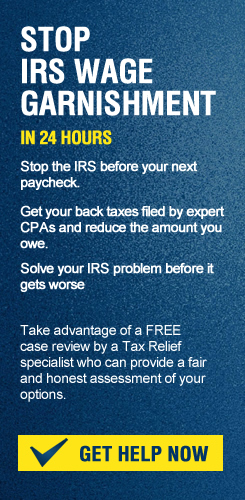We Can Help Solve Your Tax Problems
When you owe money on your federal taxes, one of the common collection actions taken is IRS tax garnishment, typically on your wages or salary. Wage garnishment can leave a person with very little money on which to live. If you already live paycheck to paycheck, then you cannot afford having the IRS take a large chunk of your earnings as a way to collect what you owe. Luckily, you have options to remove your IRS tax garnishment and maybe even reduce your tax liability.
What is IRS Wage Garnishment?
By law, the IRS has the right to collect what you owe on your taxes, including any back taxes, by taking the money directly from your wages or salary. This special type of levy is known as garnishment. An IRS tax garnishment can also be taken against any tax returns or other income; however, the most common type is on a person’s wages or salary. By law, the employer must comply and provide the IRS with the funds directly once a wage garnishment is in place. An IRS tax garnishment typically leaves a person with very little on which to live.
How Much Money Does the IRS Take?
Unlike many creditors, the IRS has no maximum amount of money they can take when garnishing your wages. Instead, they have an amount calculated for which you are exempt from paying. This is the amount they believe you need to live, based upon your filing status and deductions. Once they have calculated how much you need per month to live, based upon a tax table calculation, they will take the rest of your paycheck and apply it towards your tax debt.
The IRS Tables for Figuring the Amount Exempt from Levy on Wages, Salary and Other Income details the amount left in your paycheck, whether you are paid daily, weekly, biweekly, semimonthly, or monthly. The amount is also dependent upon how many exemptions you claim on your tax return. There is a separate table for each filing status, including Single, Married Filing Joint Return, Head of Household, and Married Filing Separate. Based upon these tables, a single person paid monthly with only one exemption will be left with $845.83 from his or her paycheck. Even if this person makes $5,000 per month, he or she will still only be left with this small amount. As another example, a married couple with six exemptions will be left with roughly $3,000 per month. These examples show how little you will be left with on an IRS wage garnishment. Typically, this will place you in a financial hardship, or make a hardship worse than it already is.
How Can you Stop an IRS Wage Garnishment?
An IRS tax garnishment continues until you pay off your debt, the statute of limitations ends on your tax liability, or the IRS removes your wage garnishment. If you are able to pay your federal tax debt in one large payment amount, this is the fastest and easiest way to remove any tax garnishment. However, most people cannot afford a payment, which is why the garnishment has happened in the first place. You do have other actions to take instead of paying such a large sum at once. You can apply for an Installment Agreement. With this tax relief solution, you pay a monthly amount towards your tax liability. You get to choose the amount, within reason, rather than the amount being forced upon you by the IRS, which is what occurs with a garnishment. With this option, you will have more of your paycheck for your monthly expenses beyond just paying off your tax debt. If you cannot afford to pay your tax debt, you can also apply for an Offer in Compromise, where you negotiate with the IRS as to how much you pay.
How Fidelity Tax Relief Helps Remove a Tax Garnishment
The tax professionals at Fidelity Tax Relief have experience working with the IRS to remove garnishments. They know the steps you need to take to apply for an IRS tax garnishment removal and will ensure that all the paperwork is handled correctly. Any errors could lead to your application being rejected, or extend the time of the garnishment while new paperwork is filed. Not only will the experts at Fidelity Tax Relief help you to get the garnishment removed, but they will also provide you with the next steps to take to reduce or remove your tax debt or set up a payment plan to get you back in compliance with the IRS.
More About Wage Garnishment
- How Much of your Income Can the IRS Take in a Tax Garnishment?
- How to Prevent IRS Wage Garnishment
- How an IRS Wage Garnishment Can Hurt your Future
- What Types of Income Are Eligible for Tax Garnishment
- The Consequences of an IRS Tax Levy
- What Assets can the IRS Seize with a Tax Levy
- What Not to Do with an IRS Wage Garnishment
- How to Get a Federal Tax Lien Withdrawal

